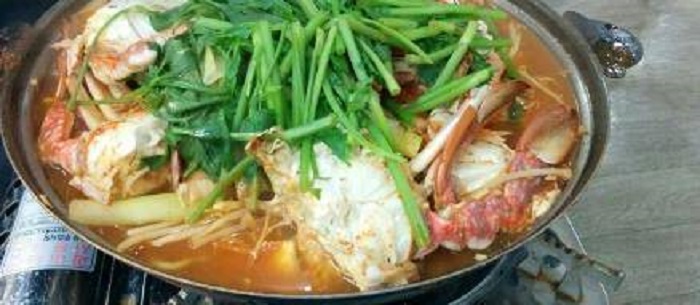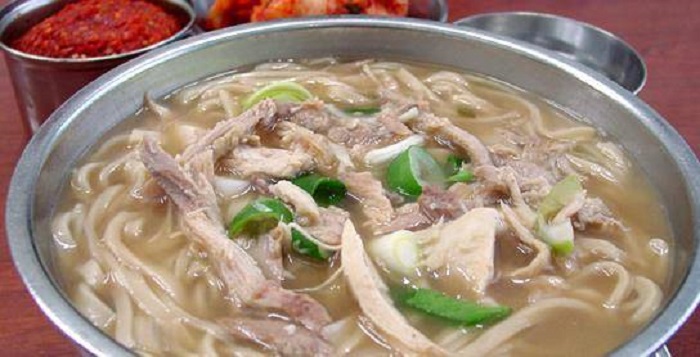Mokposan Kkotgejjim (목포산꽃게찜)
4.1Km 2021-03-29
325, Majang-ro, Seongdong-gu, Seoul
+82-2-2292-1270
A restaurant frequently featured in Korean gourmet programs. The best menu at this restaurant is steamed blue crab. This Korean dishes restaurant is located in Seongdong-gu, Seoul.
Golmok Naengmyeon (골목냉면)
4.2Km 2021-03-26
295-7, Dokseodang-ro, Seongdong-gu, Seoul
+82-2-2235-2540
This is a Seoul-style naengmyeon (Korean cold noodle) restaurant that opened in 1966. This restaurant's signature menu is cold buckwheat noodles. This Korean dishes restaurant is located in Seongdong-gu, Seoul.
Hyeseong Kalguksu (혜성칼국수)
4.2Km 2021-03-30
247-1, Wangsan-ro, Dongdaemun-gu, Seoul
+82-2-967-6918
It serves Kalguksu (chopped noodle soup), or kneaded noodles, with a 50-year tradition. The best menu at this restaurant is noodle soup with chicken. This Korean dishes restaurant is located in Dongdaemun-gu, Seoul.
Seodaemun Independence Park (서대문독립공원)
4.2Km 2022-12-15
251, Tongil-ro, Seodaemun-gu, Seoul
+82-2-3140-8305
Seodaemun Independence Park was built on the former Seoul Detention Camp. It was used to imprison thousands of Korean independence activists until the liberation from the Japanese occupation on August 15, 1945, as well as the political prisoners during the political turmoil in the 1960s. When the prison was moved to Uiwang-si, Gyeonggi-do in November 1987, the area was restored and turned into a memorial park in August 15, 1992 to honor the sacrifices of the martyrs. The park preserves seven prison buildings, an execution ground, underground women’s prison, and the March 1st Movement Monument that has been moved from Tapgol Park in Jongno.
One of the most significant monuments of the Seodaemun Independence Park is Dongnimmun Gate (Independence Gate), which has been designated a Historic Site. Nearby is Dongnipgwan (Independence Hall), originally called Mohwagwan, which was used to greet Chinese envoys during the Joseon dynasty. Today, the hall enshrines 2,327 tablets inscribed with the names of Koreans who died for the cause of national independence. Standing right next to Dongnimmun Gate are the remnants of Yeongeunmun Gate, another Historic Site. Other sights inside the park include the Patriotic Martyr Monument, Declaration of Independence Monument, and Statue of Dr. Seo Jae-pil, who was an independence activist and publisher of Korea’s first independent newspaper. The main highlight of the park is the Seodaemun Prison History Hall, a former prison building that was renovated into a history museum.
Seoullo 7017 (서울로 7017)
4.2Km 2024-10-29
432, Cheongpa-ro, Jung-gu, Seoul
+82-2-120
Originally opened in 1970, Seoullo 7017 was an elevated road that crossed over the Seoul Station railway, but when it became dilapidated and unusable for traffic, it was converted into a park in 2017. It is about 17 metres above the ground and offers a panoramic view of the Seoul Station Railway and the city of Seoul. It is directly connected to Seoul Station.
ABC-Mart - Mia Branch [Tax Refund Shop] (ABC마트 미아점)
4.2Km 2024-04-18
45, Dobong-ro, Gangbuk-gu, Seoul
-
Olive Young - Geumho Branch [Tax Refund Shop] (올리브영 금호)
4.2Km 2024-04-18
302, Dokseodang-ro, Seongdong-gu, Seoul
-
Dongnimmun Gate (독립문)
4.2Km 2022-12-15
251, Tongil-ro, Seodaemun-gu, Seoul
Dongnimmun stands at the location originally known as Yeongeun, where envoys were once treated. When a Chinese envoy visited, the King would go out through this door to greet. In 1898, to announce the independence from Japan, Dongnimun was constructed with the fund collected by the citizens. The traces of the past still remain on Dongnimmun with two pillars in front of Dongnimmun being the remains of Yeongeunmun.
The Arc de Triomphe in France can be recalled in comparison to Dongnimmun. Dongnimmun was built using granite with a passageway x_height of 14.28 meters. On the top it is written ‘Dongnimmun’ in Korean with the national flag drawn on each side. On the inner-left side there are stone stairs leading to the attic. The national flower Mugunghwa are planted around Dongnimmun. Now it is surrounded by roads and it is eye-catching to view when passing by.
Seodaemun Prison History Museum (서대문형무소역사관)
4.2Km 2024-12-02
251 Tongil-ro, Seodaemun-gu, Seoul
Seodaemun Prison was built under the Japanese administration to imprison independence movement activists. It first opened on October 21, 1908 under the name Gyeongseong Prison. Eventually, so many activists were imprisoned that the building had to be expanded. At that time, the name changed to Seodaemun Prison on September 3, 1912. Eighty years later, the prison was turned into Seodaemun Independence Park on August 15, 1992 to commemorate the Korean patriots who were tortured in prison, giving their lives for freedom. Of the many buildings, only seven were preserved for their historical significance, among which three prison buildings and the execution site were designated as a Historic Site. In 1998, the park underwent another transformation into today's Seodaemun Prison History Hall to educate the public on the importance of Korea's independence and the sacrifices of those who fought to achieve it.
Eye On Optical - Hanyang Univ. Branch [Tax Refund Shop] (아이온안경 한양대)
4.3Km 2024-04-17
#101, 30, Majo-ro, Seongdong-gu, Seoul
-



![Olive Young - Geumho Branch [Tax Refund Shop] (올리브영 금호)](http://tong.visitkorea.or.kr/cms/resource/65/2878765_image2_1.jpg)
![Eye On Optical - Hanyang Univ. Branch [Tax Refund Shop] (아이온안경 한양대)](http://tong.visitkorea.or.kr/cms/resource/77/2878777_image2_1.jpg)
 English
English
 한국어
한국어 日本語
日本語 中文(简体)
中文(简体) Deutsch
Deutsch Français
Français Español
Español Русский
Русский